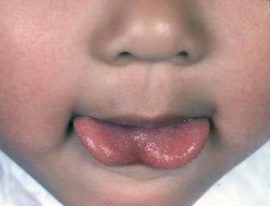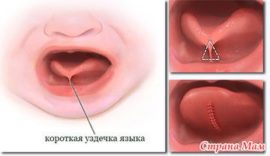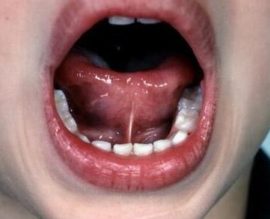Trimming the hyoid frenum in a child
Many people have heard about such an operation as cutting the frenulum under the tongue in children, but not everyone understands why and when it is necessary. The problem with the imperfection of the structure of the hyoid frenum may manifest at different ages, and parents really should pay due attention to this. Despite the fact that this part of the body seems very insignificant, it is associated with the process of eating and reproducing speech. Its anomaly can indirectly affect vital phenomena in the body.
Content
The essence of the problem
The tongue attaches to the base of the mouth with its root part. Between the tongue and the lower edge of the mouth is a small fold of skin - a bridle. Normally, it should be so long that a person can easily move his tongue, slightly stick it out of the lips, touch the front surface of the teeth, utter sounds.
A shortened bridle of the tongue greatly limits its mobility, speech capabilities and the ability to normal nutritionespecially in children. The same problems arise when it is attached incorrectly when it is in close proximity to the tip of the tongue.
The consequences are as follows:
-
During the period of breastfeeding, the baby is unable to suckle normally, as the tongue is limited in movement. Because of this, children are very anxious, cry, lose weight.
- Lack of nutrition can have a negative effect on any developing system of the body, stomach diseases appear.
- In a baby with a short bridle, an incorrect bite is formed, due to which there are dental diseases, their displacement occurs.
- After teething, when trying to stick out the tip of the tongue, the baby will injure her on the lower incisors.
- In older children, a short hyoid frenulum complicates the formation of sounds: it is difficult for them to pronounce words, the process of learning speech is delayed.
- The mechanism of breathing changes: the baby gets used to breathing through the mouth. Symptoms of pathology
The bridle in newborns normally has a length of about 8 mm and more, and in five-year-old children it increases to 17. But mothers are not always able to take measurements at home, especially if the baby is very active. And to understand whether everything is correctly located in the oral cavity, only specialists can do it.
It is possible to determine whether the child has a short bridle by some external signs:
 In infants, due to the low ability to suck milk, there is a loud smacking, clatter.
In infants, due to the low ability to suck milk, there is a loud smacking, clatter.- The baby is incorrectly applied to the chest, does not cover the areola with his mouth, so he often bites the nipple, which then becomes inflamed.
- The baby is nervous, bends, rolls with arms and legs when feeding, often throws and is applied to the chest again. Does not gain weight or even lose it.
- The tip of the tongue due to the shortening of the septum can be bifurcated. Looks like a forked tongue of a child with a short bridle, look at the photo on the right.
- In older children, speech defects are noticeable, the voice is nasal and quiet.
- Salivation is increased.
- Apnea attacks are possible.
- Due to inadequate food processing, there are digestive problems.
If parents suspect a problem, you need to contact a pediatrician or dentist.But in many cases, the defect is established by a neonatologist in the hospital.
Reasons for the defect
Short bridle of the tongue in a newborn - congenital anomalylaid in the first months of fetal development, when all organs are formed. There are several reasons for its appearance:
- The presence of a hereditary predisposition: if the parents had such a feature, it can be inherited.
- The older the expectant mother, the more likely the appearance of a shortened bridle in her child due to an increased risk of developing anomalies.
- A defect can develop if a woman during pregnancy has an infection or suffers from chronic diseases.
- Severe early toxicosis can lead to a lack of nutrients, due to which the fetal organs are formed incorrectly.
- The impact of any teratogenic factors: radiation, toxic substances, drugs that are difficult for the body, alcohol, tobacco and drugs.
- Accidents with getting pregnant injuries.
Some of these causes are independent of the actions of future parents, especially a genetic predisposition. Other risk factors should be avoided: the pregnant woman should not work in hazardous work, drink, smoke, self-medicate, or expose herself to the risk of falls during sports.
Ways to solve the problem
At the moment, there are several ways to correct:
- Cutting a bridle in children with a scalpel.
- Cutting a bridle under the tongue with a laser.
- Stretching through exercise.
- Removing a defect using massage.
Surgical interventions can be performed in different ways, the main methods are:
 Frenuloplasty - removal of a flap from the tissue of a defective bridge, which is sutured to the resulting wound to increase the mobility of the tongue. Local anesthesia is needed, but the damaged mucous membrane heals very quickly. Used for preschool children.
Frenuloplasty - removal of a flap from the tissue of a defective bridge, which is sutured to the resulting wound to increase the mobility of the tongue. Local anesthesia is needed, but the damaged mucous membrane heals very quickly. Used for preschool children.- Frenulotomy: the length of the frenulum is conditionally divided into three parts, an incision is made between the lower and middle lobes, the edges of the mucous membrane are sutured. This method is suitable for babies.
- Frenulectomy - the same manipulations, but the bridle is clamped with tools. The method is suitable for five year olds.
In more modern clinics, laser trimming is performed. Dissection is carried out after treatment with anesthetic: gel, spray. For patients, such trimming is less traumatic, damage to blood vessels is minimal - the laser simultaneously cuts the mucous membrane and causes a adhesion of the affected capillaries.
The tissue regeneration after laser cutting takes place within a few days, you can return to your usual lifestyle one hour after the procedure. But how much you need to stay in the clinic, the doctor decides. Complications are less common than after eliminating the defect with a scalpel.
Optimum age for surgery
Is it worth it to manipulate the frenulum under the tongue and at what age it is better to cut it - such decisions depend on when they discovered the anomaly, what are the individual characteristics. If the neonatologist determines that the baby has a defective hyoid frenum in the maternity hospital, it is better to do the cropping right away.
The baby is not yet so mobile as to interfere with the procedure, and the membrane itself is small, thin and does not contain blood vessels. Due to these factors, local anesthesia will be enough for manipulations, and you can calm the crumb by attaching it to the chest after surgery.
Cutting the frenum of the tongue in children after 6 months of age is associated with some difficulties. The kid becomes mobile, and parents can not discipline him by persuasion. Due to careless movements, surgical intervention may not occur correctly, which is why the operation is postponed until the age of five.
During this period, children talk, the doctor can determine if there are speech defects, whether the bridle under the tongue interferes with the child, whether it is necessary to trim or stretch it with gymnastics.
If the baby did not complete the dissection of the frenulum of the tongue, and after many years he had speech defects, developed breathing and digestion problems, then it is necessary to perform circumcision in adulthood. But the older the person, the denser the membrane becomes, he is overgrown with capillaries and nerve endings - this is why dissecting it is much more painful than in the case of the baby. An incision requires anesthesia.
Examination and contraindications
Any surgical operations in the oral cavity are a risk to the body. In order to prevent complications after the operation, it is necessary to undergo preliminary examinations, which are prescribed by the doctor. The most significant tests are blood, urine, determination of blood coagulation and fluorography.
Contraindications for frenuloplasty are infections of the throat, oral cavity, inflammatory processes in any part of the body, since pathogenic microorganisms can get into the incision of the mucous membrane. That is why a mandatory examination is carried out before the intervention. It is impossible to operate on patients with cancer, low blood coagulation.
Postoperative period
The mucous membrane in the mouth is restored quickly. But circumcision of the bridle can cause complications:
- The formation of a hard scar in the place where the incision was made.
- The development of the inflammatory process due to infection.
- Temperature increase. It manifests itself as a sign of the development of an infectious process or a peculiar reaction to the operation.
The baby can react to complications by constant anxiety, refusal of food. Children of three years and older can tell themselves what is bothering them. For any discomfort, you should consult a doctor, only a specialist will correctly assess the condition of the baby and prescribe the best treatment.
In order to avoid complications, you need to monitor the cleanliness of the oral cavity. Five-year-olds already brush their teeth and can rinse their mouth with water. For several days after the defect has been removed, do not chew solid food and talk a lotexactly how much restrictions should be observed, you need to ask your doctor. After a follow-up examination, the attending doctor will recommend special exercises for the development of frenum elasticity.
Correction with the help of gymnastics for the tongue
Only a doctor can determine whether to perform an operation on a short frenulum of the tongue in a child or whether it is better to remove the defect with the help of exercises. Therefore, even if the parents are not configured for surgical intervention, they still need to go to the pediatrician, dentist for consultation and surgery or the correct individual selection of exercises.
The possibility of conducting gymnastic classes appears when the baby can already repeat any given actions. But there are simple exercises even for newborns: they are allowed to lick a spoon of silver, drip milk on their upper lip, why they are trying to lick it, a little older smears jam.
When the baby is able to understand the requests of the mother to repeat certain actions, you can do more complex gymnastics:
- Close the mouth and feel the side walls of the tongue, the palate and the lower part of the mouth.
- Open your mouth and reach as far as possible to the outer surface of the lips.
- Click the tongue.
- Put the tongue on the lower lip and hold in this position for 10 seconds.
- Stick out your tongue as far as possible and hold for 10 seconds. You can also ask a baby in a playful way to show how long his tongue is.
Frenulum rupture
Some children with an unsuccessful fall break the frenum of the tongue. Such injury may result from close contact of the septum with the lower teeth. If the child has dissected the bridle, he may begin bleeding and swelling in the oral cavity, it becomes painful for the baby to chew and talk.
You can not rely on self-medication, you should immediately consult a doctor.Sometimes it is necessary to suture the resulting wound due to the danger of heavy bleeding.
The importance of such a part of the body as the bridle cannot be underestimated. There are many ways to lengthen a small partition to free the tongue for free speech and food. Before taking certain measures, it is necessary to consult with a specialist and do preoperative tests if it is necessary to trim the bridle.
If the anomaly causes disturbances in the functioning of the organs, then frenuloplasty is necessary, and it is better to carry out it at the age that the doctor will advise. Ignoring such a problem means exposing the child to the risk of frequent respiratory and digestive diseases, a problem in the pronunciation of sounds.
Video: short tongue bridle







